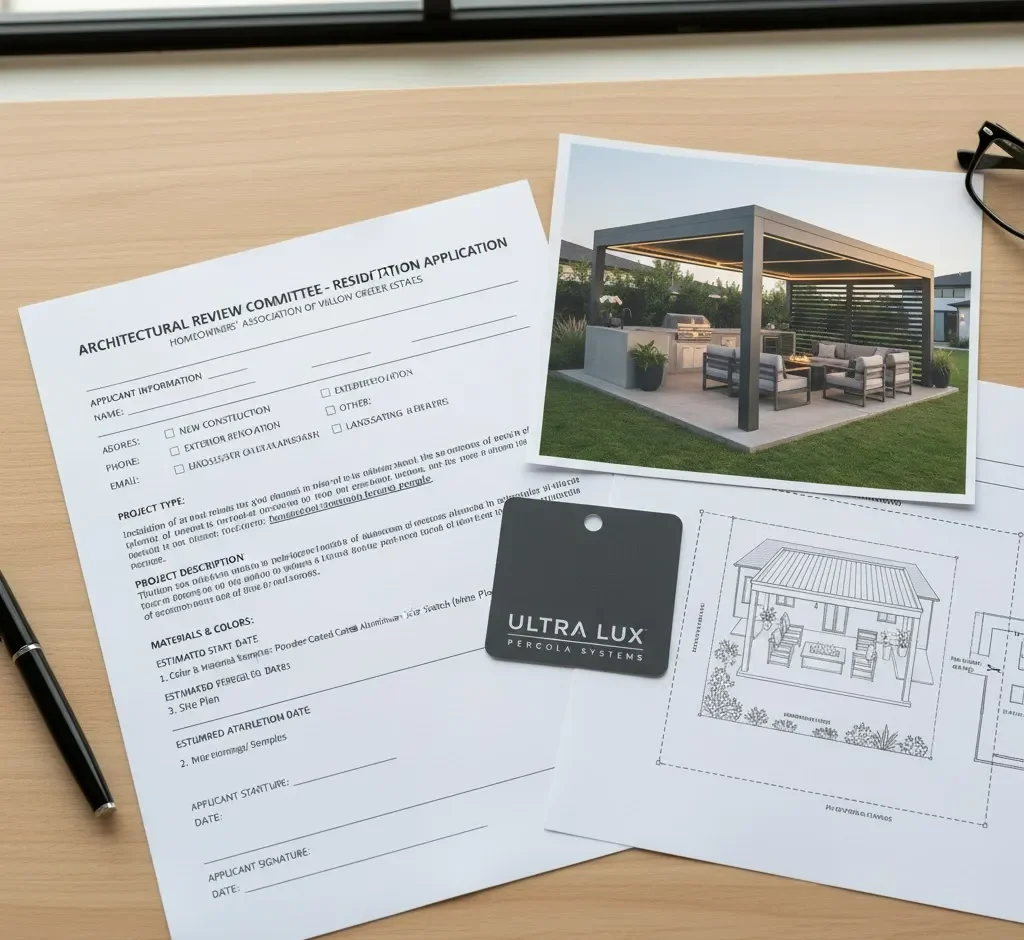Introduction: Lessons from 100+ Pergola Installations
As a factory specializing in high-end aluminum pergolas, we’re involved in hundreds of residential and light commercial projects across the United States every year. In all those consultations, the same three questions pop up before the first component is ever machined:

1. Do I actually need a pergola permit for this?
2. What specific documents do I need to submit?
3. How long is this going to take?
This is Your Actionable Guide
This article isn’t legal advice, but it is a guide forged from our frontline delivery and installation experience. We’ll break down the lessons we’ve learned into practical, actionable steps to help you quickly determine your requirements, get your materials in order, and (most importantly) get your project approved the first time.
What is a Pergola Permit (And Why Does Your City Care)?
Let’s clarify this first. A pergola permit is an official document issued by your local government (city, county, or township) that grants you legal permission to construct your pergola.
It’s a common misconception that permits are just a bureaucratic cash grab. In reality, the primary purpose of a permit is to protect people’s property and personal safety. Local building departments are not concerned with your pergola’s color or style.
Their job is to enforce the local building codes, which are designed to protect you, your property, and your neighbors from:
Structural Failure
Will your pergola withstand a heavy snow load or high winds? Is it anchored correctly so it doesn’t tip over?
Fire Hazards
Is the structure too close to your home’s eaves or a property line?
Electrical Hazards
If you’re adding lights, fans, or outlets, is the wiring safe, weatherproof, and to code (e.g., GFCI protected)?
Zoning Conflicts
Does your project infringe on utility easements or violate setback rules (how far a structure must be from your property line)?
A permit ensures your project is reviewed and, in some cases, inspected to meet these critical safety standards.
Do I Need a Permit? The Key Factors Checklist
Determining if you need a pergola permit comes down to how your local municipality classifies the structure. While every city’s zoning code is different, they almost all use the same set of criteria to decide whether a project requires oversight.
If your project meets ANY ONE of the following criteria, you should assume a permit is required:
1. Attachment (Attached vs. Freestanding)
This is often the primary deciding factor.
Attached Structures: Building a pergola attached to the house (anchored to an exterior wall or existing deck) is legally considered an addition to the primary residence. This almost always requires a building permit because it imposes new loads on the existing home’s structure.
Freestanding Structures: These are classified as accessory structures and may qualify for exemptions if they meet other criteria below.
2. Size and Footprint

Most jurisdictions have a square footage threshold for accessory structures.
The 120 Sq. Ft. Rule: A common standard in many U.S. building codes (derived from the International Residential Code) is that freestanding structures under 120 square feet—roughly a 10’x12′ footprint—do not require a building permit.
Larger Structures: If you are planning a pergola 12×12 plans (144 sq. ft.) or larger, you likely cross this threshold and will need a permit regardless of other factors.
3. Utilities (Electricity and Gas)
Adding amenities often triggers a permit requirement for safety reasons, even for small structures.
Electrical: Any permanent wiring for lights, ceiling fans, or outlets typically requires an electrical permit.
Gas: Running a natural gas line for a built-in fire pit or heater requires a plumbing/mechanical permit.
4. Roof and Enclosure (The Pergola Definition)
A traditional pergola has an open, lattice, or louvered roof. Changing this definition can change the permit requirements.
Solid Roofs: Adding a completely solid, non-adjustable roof may reclassify the structure as a patio cover or carport, which often have stricter snow/wind load requirements.
Walls/Sides: Adding permanent walls or creating a pergola with sides can reclassify it as an enclosed structure or sunroom, triggering much more complex code requirements regarding egress (exits) and ventilation.
5. Location (Zoning & Setbacks)
Even if a structure is exempt from a building permit due to its small size, it must still comply with zoning laws.
Setbacks: Every property has setbacks—invisible lines running parallel to your property boundaries where you cannot build. You generally cannot place a pergola right against a neighbor’s fence.
Easements: You cannot build permanent structures on designated utility easements.
The Double-Approval Trap: City Permit vs. HOA Rules
This is the single biggest point of confusion we see.
You MUST understand: A City Permit and HOA Approval are TWO SEPARATE THINGS.
Getting one does not mean you have the other.
The City/County Permit:
Cares about SAFETY (Structural, Electrical, Setbacks). They don’t care about your color choice.

The HOA Approval:
Cares about AESTHETICS (Color, Style, Materials, Height, Location). They are enforcing the community’s rulebook (CC&Rs) to maintain property values.
An HOA can deny your project for having the wrong shade of white even if the city gave you a permit. Conversely, your HOA might approve your beautiful pergola 12×12 plans, but the city will deny them because the location is on top of a utility easement.
The Factory Experience: Which One Comes First?
Our advice, backed by years of experience: Submit your application to your HOA first.
Why? Because HOAs are more likely to request design changes (e.g., You can’t have black, it must be bronze or It’s 6 inches too tall). These design changes would force you to amend your plans and re-submit (and pay) for your city permit again. Get the aesthetic approval first, then submit those finalized plans to the city for the safety check.
Real Talk: What Happens If You Build a Pergola Without a Permit?
You might be tempted to just build it and hope for the best. But as a responsible manufacturer, we don’t recommend it, because we’ve encountered the same situation before. This is a very real scenario that answers the question, what happens if you build a pergola without a permit.
A client in a suburb outside Austin, TX, purchased a large 16’x20′ motorized pergola. They confirmed it was “fine” with their HOA but did not check with the city.
The Incident:
The installation team was halfway through the build when a neighbor—who was in a dispute with the homeowner about a tree—called the city. An inspector was on-site within three hours and issued a Red Tag Stop-Work Order.
The Fallout:
All work had to cease immediately. The homeowner was required to:
- Pay an initial fine for building without a permit.
- Hire a local engineer to create post-facto structural drawings and a site Plan.
- Submit these plans to the city, where they were flagged for being 2 feet inside the side-yard setback.
- Pay a second, larger fine (often double or triple the original permit fee) as a penalty.
- Wait an additional six weeks for the permit to be reviewed and approved.
The Result:
Although the project was completed normally, it was stalled for six weeks, and the client wasted nearly $4,000 in fines. Furthermore, the pergola’s location was outside the planned area, requiring a redesign of the pergola’s location, incurring an additional $500 in redesign fees.
The Safe Harbor: What Size Pergola Can I Build Without a Permit?
So, what size pergola can i build without a permit? While you must always check locally, your lowest-risk safe harbor option generally has these characteristics:
Size: Under 120 square feet (e.g., pergola kits 10 x 10 or an 8 x 10 pergola).
Structure: Freestanding (NOT building a pergola attached to the house).
Utilities: No electricity, gas, or plumbing.
Location: Well clear of all property lines and easements.
WARNING:
Even if your project meets all these criteria and is exempt from a building permit, it is almost certainly NOT exempt from:
- A Zoning Permit: A simpler review to ensure you’re meeting setback rules.
- HOA Approval: Your HOA will still want to approve the style and location.
The Safe Harbor: What Size Pergola Can I Build Without a Permit?
So, what size pergola can i build without a permit? While you must always check locally, your lowest-risk safe harbor option generally has these characteristics:
Size: Under 120 square feet (e.g., pergola kits 10ft x 10ft or an 8ft x 10ft pergola).
Structure: Freestanding (NOT building a pergola attached to the house).
Utilities: No electricity, gas, or plumbing.
Location:Well clear of all property lines and easements.
WARNING:
Even if your project meets all these criteria and is exempt from a building permit, it is almost certainly NOT exempt from:
- A Zoning Permit: A simpler review to ensure you’re meeting setback rules.
- HOA Approval: Your HOA will still want to approve the style and location.
The First Battle: How to Get HOA Approval (Step-by-Step)
Before you even talk to the city, you must conquer your Homeowners’ Association. HOAs are notoriously strict about aesthetics. Their goal is uniformity.

The HOA Package: Documents You Will Need
- ARC Form: The “Architectural Review Committee” application form found on your HOA’s portal.
- Color & Material Samples: Crucial! They want to see the exact shade of powder-coated aluminum you are using. As a factory, we often ship small metal color chips to clients just for this purpose.
- Renderings/Photos: A clear picture of what the final pergola will look like.
- Site Plan: Showing where it sits in your yard relative to your neighbors’ fences.
Step 1: Read Your CC&Rs (The Rulebook)
Find your community’s Covenants, Conditions, and Restrictions (CC&Rs). Look for keywords like “outbuildings,” “accessory structures,” or “patio covers.” See if aluminum is even allowed (some strict HOAs only allow wood).
Step 2: Communicate your plans for the pergola with your neighbors first (very important).
Nothing sinks an HOA application faster than a complaining neighbor. Show them your plans before you submit. If they are on board, the HOA board is much more likely to approve it.
Step 3: Submit and Wait for the Meeting
Submit your HOA Package. The board usually meets once a month to review these. You might need to attend to answer questions.
Step 4: Get the Official Approval Letter
Do not start building based on a verbal “it’s fine.” Get the official, signed approval letter. You will often need to show this letter to the city to get your building permit.
How to Get Your Pergola Permit: A 5-Step Action Plan
Step 1: Research (The 30-Minute Call That Saves 3 Weeks)
Call your local Building Department and your HOA. Use this script: “Hi, I’m planning to install a [SIZE] pergola. It will be [FREESTANDING/ATTACHED] and [WILL/WILL NOT] have electricity. Can you please tell me what permits and approvals I will need?”
Step 2: Assemble Your Permit Package
You will likely need:
- Site Plan: This is the most important document. It’s a simple, top-down map of your property. It must show your house, your property lines, and the exact location and dimensions of the proposed pergola, with measurements to the property lines.
- Manufacturer’s Drawings: This is where we, as a aluminum pergola manufacturer, help. We provide the detailed engineering specifications, drawings, and anchoring details for the specific model you are purchasing. If you are custom-building, you will need your own pergola 12×12 plans or similar.
- HOA Application: This usually includes the above, plus material lists and color swatches.
- Permit Application: The form from your city’s website.
Step 3: Submit (HOA First, Then City)
As advised, submit your package to the HOA. Get their signed-off approval letter. Then, take that letter, along with the rest of your package, to the city’s building department.
Step 4: The Review & Inspection Process
The city plan reviewer will check your documents. This can take anywhere from one day to eight weeks. Once approved, you pay the fee and get your permit. You must post this permit visibly on your property during construction. The permit may require one or two inspections:
- Footing Inspection: (If you are digging concrete footers) An inspector checks the holes before you pour the concrete.
- Final Inspection: An inspector signs off on the completed structure and any electrical work.
Step 5: Approval! (File, Don’t Forget)
Once you pass the final inspection, you are done. File all your approval documents, plans, and certificates in a safe place. You will need them if you ever sell your home.
Pro-Tips from the Factory (Our Insider Checklist)
Call 811 (Call Before You Dig): Before you dig any footers, call 811. It’s a free national service that will send local utilities to mark the location of underground gas, electric, and water lines.
The Anchor is Everything: We’ve seen inspectors fail projects for one reason: improper anchoring. Your pergola permit requirements will specify how to anchor the posts. This is a critical safety step. [See our Complete Guide to Anchoring Your Pergola] for more.
Future-Proof Your Electrical: Even if you don’t need electrical now, if you’re pouring a concrete slab, it costs very little to have an electrician run an empty conduit pipe before you pour. This makes adding a fan or outlet in the future a thousand times easier.
The Contractor’s Role: If you hire a contractor, insist that they are responsible for pulling the permit. This places the legal responsibility for passing inspections on them. If a contractor asks you to pull the permit as an “owner-builder,” it can be a red flag.
Conclusion: A Smooth Project Starts Here
Navigating the pergola permit and HOA process can feel intimidating, but it is the single most important step in protecting your investment. A few hours of paperwork and a few hundred dollars in fees are a tiny price to pay to avoid a $4,000 fine, a six-week stop-work order, or a catastrophic failure in a storm.
This guide, built from the experience of hundreds of projects, is designed to demystify the process. By understanding what your city and HOA care about—Safety and Aesthetics—and by preparing your Permit Package correctly, you can ensure your project moves from a dream to a reality, smoothly, safely, and successfully.
Pergola Permit FAQ (Frequently Asked Questions)
1. How much does a pergola permit cost in the U.S.?
The cost varies dramatically. An simple zoning permit might be $50. A full building permit for a large, attached pergola with electrical work could range from $150 to $500, or more, depending on your city and the project’s total value.
2. How long does the approval process take?
HOA approval can be fast (a few days) or slow (if they only meet once a month). A city permit review can take anywhere from a same-day over-the-counter approval for a simple project, to 4-8 weeks for a complex one in a busy jurisdiction.
3. Does my contractor handle the permits?
A reputable, licensed contractor should offer to handle the entire permit application process (often called pulling the permit) as part of their fee. As the homeowner, you are ultimately legally responsible for the project, so ensure this is clearly stipulated in your contract.
4. What’s the difference between a Building Permit and a Zoning Permit?
A Zoning Permit is simpler and cheaper. It just checks your project’s location against zoning rules (Setbacks, Easements, Height). A Building Permit is more complex. It checks the structure itself for safety (Anchoring, snow/wind load, electrical code). You may need one, or both.
5. Can I get a permit for pre-built pergola kits?
Yes. In fact, it’s often easier. High-quality pergola kits 10 x 10 or larger will come with engineering drawings and specifications. As a factory, we provide these documents specifically to be included in your permit application, which saves you the cost of hiring an engineer to draw up plans.
Disclaimer
This guide is for informational purposes only, based on our experience in the industry. It is not legal advice.
All projects are unique. You must consult your local building department and HOA to determine the specific requirements for your property.

